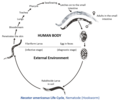Necator americanus
Necator americanus is a species of nematode that is one of the principal agents responsible for hookworm infection. This parasitic worm is prevalent in subtropical and tropical regions, affecting millions of people worldwide.
Life Cycle[edit]
The life cycle of Necator americanus begins when the eggs are excreted in the feces of an infected host. These eggs hatch into larvae in the soil, which can then penetrate the skin of a new host. Once inside the host, the larvae migrate to the lungs, are coughed up and swallowed, and then reach the small intestine, where they mature into adult worms. The adult worms attach to the intestinal wall and feed on the host's blood, leading to anemia.
Pathology[edit]
The primary health impact of Necator americanus is due to the blood loss it causes, leading to iron-deficiency anemia. Other symptoms can include abdominal pain, diarrhea, and weight loss. In children, chronic infection can lead to malnutrition and cognitive impairment.
Treatment and Control[edit]
Treatment for Necator americanus infection typically involves anthelmintic drugs such as albendazole or mebendazole. Control measures include improved sanitation to prevent soil contamination with feces, and the use of shoes to prevent skin contact with contaminated soil.
Epidemiology[edit]
Necator americanus is most prevalent in areas with warm, moist soil, particularly in parts of Sub-Saharan Africa, Southeast Asia, and Latin America. It is estimated that hundreds of millions of people are infected worldwide.
History[edit]
The hookworm was first described in the 19th century, and was recognized as a major public health problem in the southern United States in the early 20th century. Efforts to control the parasite have significantly reduced its prevalence in some areas, but it remains a significant cause of disease in many parts of the world.
Necator_americanus[edit]
-
Necator americanus L3 larva at 1000x magnification
-
Necator americanus Life Cycle
Ad. Transform your life with W8MD's Budget GLP-1 injections from $75


W8MD offers a medical weight loss program to lose weight in Philadelphia. Our physician-supervised medical weight loss provides:
- Weight loss injections in NYC (generic and brand names):
- Zepbound / Mounjaro, Wegovy / Ozempic, Saxenda
- Most insurances accepted or discounted self-pay rates. We will obtain insurance prior authorizations if needed.
- Generic GLP1 weight loss injections from $75 for the starting dose.
- Also offer prescription weight loss medications including Phentermine, Qsymia, Diethylpropion, Contrave etc.
NYC weight loss doctor appointmentsNYC weight loss doctor appointments
Start your NYC weight loss journey today at our NYC medical weight loss and Philadelphia medical weight loss clinics.
- Call 718-946-5500 to lose weight in NYC or for medical weight loss in Philadelphia 215-676-2334.
- Tags:NYC medical weight loss, Philadelphia lose weight Zepbound NYC, Budget GLP1 weight loss injections, Wegovy Philadelphia, Wegovy NYC, Philadelphia medical weight loss, Brookly weight loss and Wegovy NYC
|
WikiMD's Wellness Encyclopedia |
| Let Food Be Thy Medicine Medicine Thy Food - Hippocrates |
Medical Disclaimer: WikiMD is not a substitute for professional medical advice. The information on WikiMD is provided as an information resource only, may be incorrect, outdated or misleading, and is not to be used or relied on for any diagnostic or treatment purposes. Please consult your health care provider before making any healthcare decisions or for guidance about a specific medical condition. WikiMD expressly disclaims responsibility, and shall have no liability, for any damages, loss, injury, or liability whatsoever suffered as a result of your reliance on the information contained in this site. By visiting this site you agree to the foregoing terms and conditions, which may from time to time be changed or supplemented by WikiMD. If you do not agree to the foregoing terms and conditions, you should not enter or use this site. See full disclaimer.
Credits:Most images are courtesy of Wikimedia commons, and templates, categories Wikipedia, licensed under CC BY SA or similar.
Translate this page: - East Asian
中文,
日本,
한국어,
South Asian
हिन्दी,
தமிழ்,
తెలుగు,
Urdu,
ಕನ್ನಡ,
Southeast Asian
Indonesian,
Vietnamese,
Thai,
မြန်မာဘာသာ,
বাংলা
European
español,
Deutsch,
français,
Greek,
português do Brasil,
polski,
română,
русский,
Nederlands,
norsk,
svenska,
suomi,
Italian
Middle Eastern & African
عربى,
Turkish,
Persian,
Hebrew,
Afrikaans,
isiZulu,
Kiswahili,
Other
Bulgarian,
Hungarian,
Czech,
Swedish,
മലയാളം,
मराठी,
ਪੰਜਾਬੀ,
ગુજરાતી,
Portuguese,
Ukrainian



